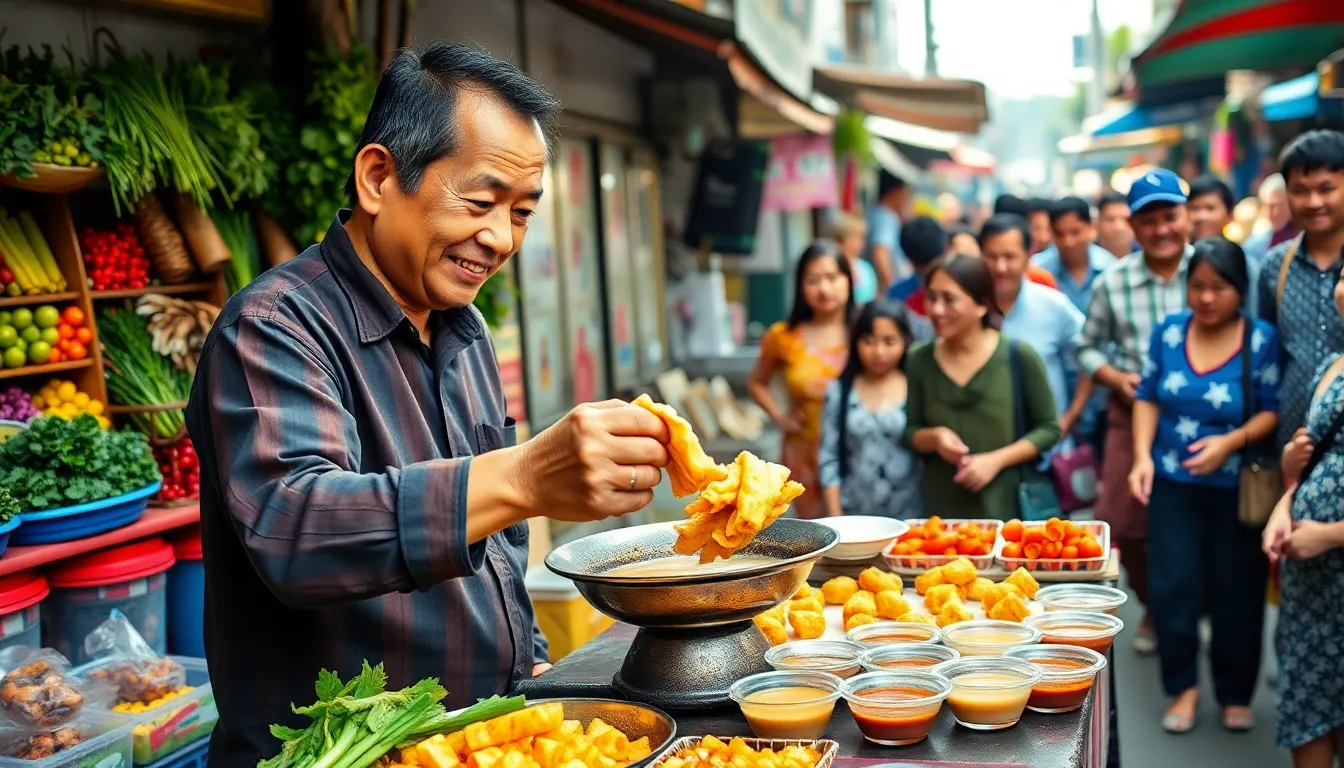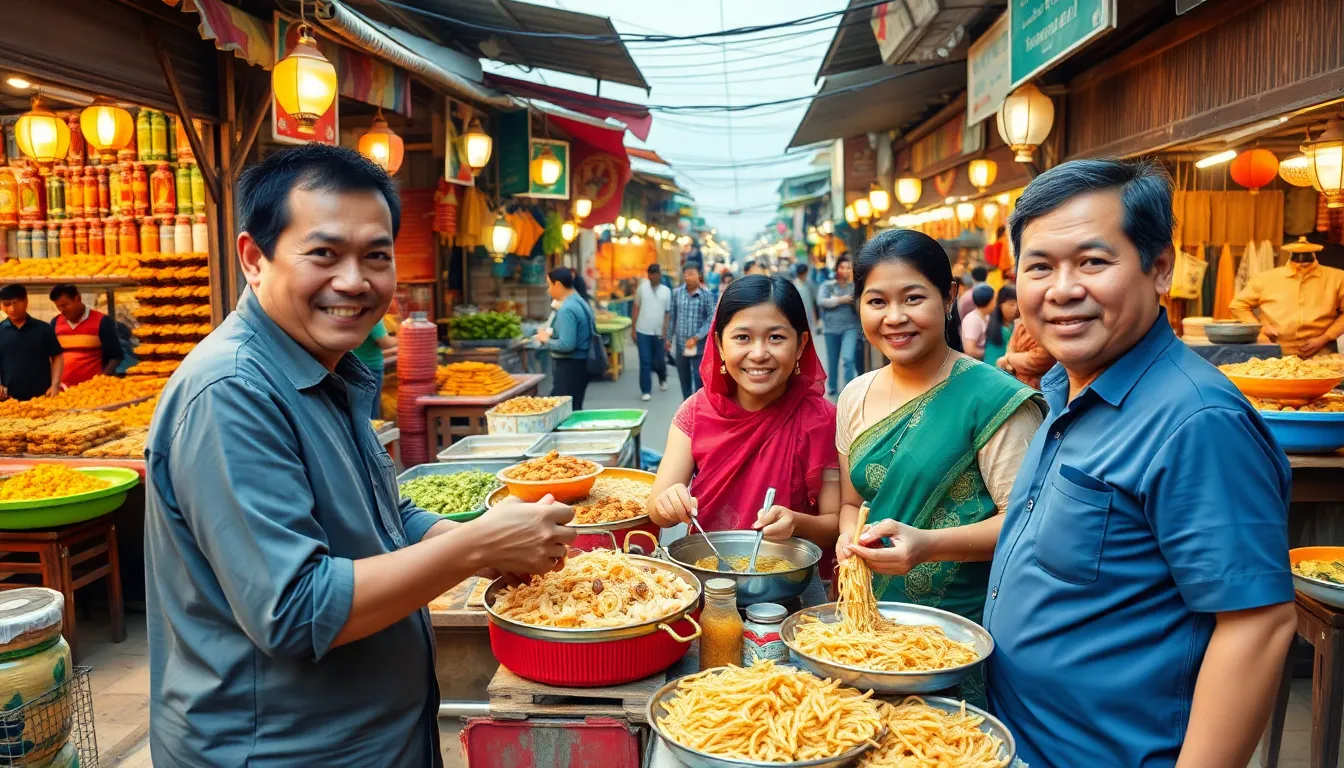
In the bustling streets of Myanmar, a culinary gem awaits discovery: hingagyi. This delightful dish, often overshadowed by its more famous counterparts, packs a flavor punch that could make even the most stoic food critic weak at the knees. Imagine biting into a warm, crispy treat that’s as comforting as a hug from your grandma—only tastier.
Hingagyi isn’t just food; it’s an experience. Whether it’s the savory filling or the crispy exterior, it’s no wonder locals can’t get enough. If you think you’ve tasted it all, think again. This dish has a way of sneaking into your heart (and stomach) when you least expect it. So grab a seat, loosen that belt, and get ready to dive into the world of hingagyi—where every bite tells a story and leaves you craving more.
Food Named Hingagyi in Myanmar
Hingagyi serves as a traditional Myanmar dish, known for its rich flavors and satisfying texture. This culinary specialty features a crispy outer shell filled with a savory blend of ingredients, often including meat, vegetables, and spices. Each locale may present its unique variation, allowing for diverse tastes throughout Myanmar.
Locals typically enjoy hingagyi as a snack or a light meal, often paired with a dipping sauce to enhance its flavor profile. Popular fillings include minced pork, chicken, or tofu, seasoned with aromatic herbs and spices that create a delightful experience. Vendors often sell hingagyi at street markets and festivals, making it easily accessible to both residents and visitors.
Preparation involves wrapping the filling in thin sheets of dough before frying until golden brown. This cooking method ensures a crunchy exterior while keeping the inside warm and flavorful. The dish benefits from fresh ingredients, and the use of local spices contributes to its authentic taste, making each bite memorable.
Hingagyi captures the essence of Myanmar’s culinary culture, showcasing the harmony of simple ingredients transformed into a delightful treat. With its whimsical appearance and comforting flavors, this dish holds a special place in the hearts of many. Appreciating hingagyi provides insight into Myanmar’s rich gastronomic heritage and its emphasis on communal dining experiences.
History of Hingagyi

Hingagyi holds a rich legacy in Myanmar’s culinary scene, reflective of the country’s diverse cultures and traditions. This dish has been enjoyed for generations, with roots tracing back to both local and regional influences.
Cultural Significance
Hingagyi embodies Myanmar’s communal spirit. Vendors sell this dish at lively street markets, fostering social gatherings and shared experiences. Celebrations often feature hingagyi, showcasing its role in festivities and family gatherings. It’s not just a snack; it symbolizes hospitality, welcoming guests with warmth and flavor. Families often prepare it together, reinforcing bonds and heritage through cooking.
Regional Variations
Regional variations of hingagyi exist across Myanmar, highlighting local tastes and ingredients. In urban centers, street vendors might incorporate more modern twists, using different fillings like spicy shrimp or unique sauces. Rural areas tend to focus on traditional recipes, emphasizing local produce. Each region presents its variant, ensuring that the dish remains dynamic and relevant. Popular fillings can include a mix of meat and vegetables tailored to local preferences. Different cooking techniques may also influence texture and flavor, creating a diverse experience for those who taste hingagyi across the country.
Ingredients Used in Hingagyi
Hingagyi features a variety of ingredients that contribute to its unique flavor and texture. Commonly, this dish includes a crispy outer shell and a savory filling, making it a delightful treat in Myanmar.
Common Components
Minced pork frequently serves as the primary filling in hingagyi. Chicken or tofu also provides alternatives for those preferring different proteins. Aromatic herbs like garlic, onion, and ginger enhance the flavor profile, while vegetables such as carrots and scallions add crunch. Various spices like turmeric and chili powder contribute warmth, making each bite satisfying. Dough, thinly rolled and pliable, wraps around these fillings, ensuring a crispy texture after frying.
Unique Additions
Regional variations often introduce unique additions to hingagyi. Some vendors use spicy shrimp or beef, reflecting local preferences. Creative cooks may incorporate elements like fried onions or fresh cilantro for added flavor. Unique dipping sauces, such as spicy chili or tangy tamarind, often accompany the dish, enhancing the overall taste experience. In urban settings, innovative spins on traditional recipes showcase the adaptability of hingagyi, catering to adventurous palates while retaining its cultural essence.
Preparation Methods
Hingagyi preparation showcases a blend of traditional methods and modern adaptations. Each technique contributes to the dish’s unique flavor and texture.
Traditional Techniques
Traditional hingagyi involves several hands-on methods. Street vendors typically prepare dough by mixing flour with water, kneading until smooth. For filling, cooks use ingredients like minced pork, chicken, or tofu, seasoned with herbs such as garlic and ginger. Cooks wrap the filling in thin sheets of dough, ensuring each piece is tightly sealed. Frying occurs in hot oil until the outer layer becomes golden brown and crispy. This method retains the warmth of the filling, creating a delightful contrast in texture. Community gatherings often feature families working together, sharing skills while preparing this beloved dish.
Modern Adaptations
Modern adaptations of hingagyi introduce innovative techniques and flavors. Chefs experiment with different types of dough, such as gluten-free options, appealing to diverse diets. Unique fillings, including spicy shrimp or vegetarian blends, cater to evolving palates. Baking has emerged as an alternative to frying, offering a healthier option while maintaining flavor. Vendors often create signature dipping sauces, enhancing the dish’s appeal. Creative presentations, such as deconstructed versions served in bowls, attract younger audiences. Overall, these adaptations keep hingagyi relevant in today’s culinary landscape, honoring tradition while embracing change.
A Symbol of Hospitality And Warmth
Hingagyi stands out as a cherished culinary gem in Myanmar’s diverse food landscape. Its delightful combination of crispy texture and savory fillings captures the essence of communal dining. As street vendors continue to serve this beloved dish at markets and festivals, it remains a symbol of hospitality and warmth.
The adaptability of hingagyi, with its regional variations and modern twists, ensures it resonates with both tradition and contemporary tastes. Each bite not only offers a unique flavor experience but also connects diners to Myanmar’s rich cultural heritage. Embracing both the past and the present, hingagyi is more than just food; it’s a celebration of community and shared memories.







